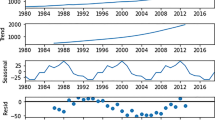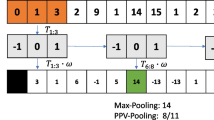Abstract
Mining operations provide the coal required to satisfy more than 36% of the electricity demand worldwide. Coal mining releases methane gas which constitutes a significant risk for the safety of coal miners working underground. Therefore, early warning of rising methane gas concentrations is critical to preventing accidents and loss of life. The prediction of methane concentration is complicated by its dependence on many factors and the presence of stochastic fluctuations. This paper introduces a new forecasting approach for methane gas emissions in underground coal mines. The proposed approach employs univariate and multivariate time series forecasting methods. Multivariate methods incorporate barometric pressure as a predictor of gas concentration. The data used herein were collected from the Atmospheric Monitoring Systems of three active underground coal mines in the eastern USA. The performance of three time series methods is compared: the univariate autoregressive integrated moving average (ARIMA), the multivariate vector autoregressive (VAR), and ARIMA with exogenous inputs (ARIMAX). The optimal model per method (ARIMA, VAR, ARIMAX) is selected based on the Akaike Information Criterion. The forecasting performance is assessed using cross-validation to determine the best overall model. It is concluded that all three methods can, in most cases, satisfactorily predict methane gas concentrations in underground coal mines.






Similar content being viewed by others
Data Availability
The data used in this paper have been provided by mining companies and they will not be shared with third parties due to non-disclosure agreement.
References
Agioutantis Z, Luxbacher K, Karmis M et al (2014) Development of an atmospheric data-management system for underground coal mines. J S Afr Inst Min Metall 114(12):1059–1063
Agou VD, Pavlides A, Hristopulos DT (2022) Spatial modeling of precipitation based on data-driven warping of Gaussian processes. Entropy 24(3):321. https://doi.org/10.3390/e24030321
Airey EM (1968) Gas emission from broken coal. An experimental and theoretical investigation. Int J Rock Mech Min Sci Geomech Abstr 5(6):475–494
American Physical Society and Optica (2022) Joint report on methane emissions. https://www.aps.org/newsroom/pressreleases/methane-report.cfm
Andrews BH, Dean MD, Swain R, et al (2013) The National Institute for Occupational Safety and Health. Data and Statistics. Society of Actuaries, https://www.soa.org/globalassets/assets/files/research/projects/research-2013-arima-arimax-ben-appl-rates.pdf
Bessac J, Naveau P (2021) Forecast score distributions with imperfect observations. Adv Stat Climatol Meteorol Oceanogr 7(2):53–71. https://doi.org/10.5194/ascmo-7-53-2021
Booth P, Nemcik J, Ren T (2016) A critical review and new approach for determination of transient gas emission behaviour in underground coal mines. In: Aziz N, Kininmonth B (eds) Proceedings of the 16th Coal Operators’ Conference, February 10–12. The University of Wollongong Printery, Australia, pp 367–379. https://ro.uow.edu.au/coal/
Booth P, Brown H, Nemcik J et al (2017) Spatial context in the calculation of gas emissions for underground coal mines. Int J Min Sci Technol 27(5):787–794. https://doi.org/10.1016/j.ijmst.2017.07.007
Box GE, Jenkins GM, Reinsel GC et al (2015) Time Series Analysis: Forecasting and Control, 5th edn. Wiley, Hoboken, USA
Brockwell PJ, Davis RA (2009) Time Series: Theory and Methods. Springer, Heidelberg
Byrer C, Havryluk I, Uhrin D (2014) Coalbed methane: a miner’s curse and a valuable resource. In: Pramod T, Schatzel S, Aminian K (eds) Coal Bed Methane: From Prospect to Pipeline. Elsevier, Amsterdam, pp 1–6
Chatfield C (2004) The Analysis of Time Series: An Introduction, 6th edn. Chapman & Hall, New York, USA
Chilès JP, Delfiner P (2012) Geostatistics: Modeling Spatial Uncertainty, 2nd edn. Wiley, Hoboken, USA
De Iaco S, Hristopulos DT, Lin G (2022) Special issue: geostatistics and machine learning. Math Geosci 54:459–465. https://doi.org/10.1007/s11004-022-09998-6
Diaz J, Agioutantis Z, Hristopulos DT et al (2021a) Managing and utilizing big data in atmospheric monitoring systems for underground coal mines. Mater Proc 5(1):78. https://doi.org/10.3390/materproc2021005078
Diaz J, Agioutantis Z, Schafrik S, et al (2021b) Towards atmospheric monitoring data analysis in underground coal mines. In: Tukkaraja P (ed) Proceedings of the 18th North American Mine Ventilation Symposium (NAMVS 2021), June 21–23. CRC Press, Boca Raton, pp 498–506
Diaz J, Agioutantis Z, Hristopulos DT et al (2022) Time series modeling of methane gas in underground mines. Min Metall Explor 39:1961–1982. https://doi.org/10.1007/s42461-022-00654-5
Dixon DW (1992) A statistical analysis of monitored data for methane prediction. PhD thesis, University of Nottingham, Nottingham, UK, http://eprints.nottingham.ac.uk/12977/1/334922.pdf
Dixon DW, Longson I (1993) A statistical method for methane prediction and improved environmental control. In: Proceedings of the 6th US Mine Ventilation Symposium, Salt Lake City
Dunmore R (1982) Predicting methane in real-time for longwall faces. In: Hartman HL (ed) Proceedings of the 1st Mine Ventilation Symposium, March 29–31, the University of Alabama, Tuscaloosa, Alabama. Society for Mining, Metallurgy and Exploration
Enders W (2014) Applied Econometric Time Series, 4th edn. Wiley, Hoboken, USA
Environmental Protection Agency (2021) About coal mine methane. https://www.epa.gov/cmop/about-coal-mine-methane#q2
Flores RM (1998) Coalbed methane: from hazard to resource. Int J Coal Geol 35(1–4):3–26. https://doi.org/10.1016/S0166-5162(97)00043-8
Ghasemi A, Zahediasl S (2012) Normality tests for statistical analysis: a guide for non-statisticians. Int J Endocrinol Metab 10:486–489. https://doi.org/10.5812/ijem.3505
Gneiting T, Raftery AE (2007) Strictly proper scoring rules, prediction, and estimation. J Am Stat Assoc 102(477):359–378. https://doi.org/10.1198/016214506000001437
Guo H, Adhikary D, Craig M (2009) Simulation of mine water inflow and gas emission during longwall mining. Rock Mech Rock Eng 42(1):25–51. https://doi.org/10.1007/s00603-008-0168-9
Hemp R (1994) The effect of changes in barometric pressure on mines in the highveld of South Africa. J S Afr Inst Min Metall 94(6):133–146
Hristopulos DT (2020) Random Fields for Spatial Data Modeling: A Primer for Scientists and Engineers. Springer, Heidelberg
Hyndman RJ, Athanasopoulos G (2021) Forecasting: Principles and Practice, 3rd edn. OTexts, Melbourne, Australia
Johansen S (1995) The vector autoregressive model. In: Likelihood-Based Inference in Cointegrated Vector Autoregressive Models. Oxford University Press, Oxford
Karacan CO (2008) Modeling and prediction of ventilation methane emissions of U.S. longwall mines using supervised artificial neural networks. Int J Coal Geol 73(3–4):371–387. https://doi.org/10.1016/j.coal.2007.09.003
Kirchgessner DA, Piccot SD, Winkler JD (1993) Estimate of global methane emissions from coal mines. Chemosphere 26(1–4):453–472
Kirchgässner G, Wolters J (2007) Introduction to modern time series analysis. Springer, Berlin, Germany
Kissell FN, Diamond WP, Beiter DA, et al (2006) Handbook for methane control in mining. National Institute for Occupational Safety and Health, Pittsburgh, PA
Lolon SA (2017) Computational modeling of barometric pressure fluctuation effects on explosive methane-air mixtures in a longwall mine gob. PhD thesis, Colorado School of Mines, Colorado, USA
Lütkepohl H (2005) New introduction to multiple time series analysis. Springer, Berlin
McAteer D (2014) Monongah: the tragic story of the 1907 monongah mine disaster. West Virginia University Press, Morgantown
NIOSH (2020) Traumatic occupational injuries. https://www.cdc.gov/niosh/injury/data.html. Accessed on 02 Feb 2022
NIST/SEMATECH (2012) e-Handbook of statistical methods. National Institute of Standards and Technology, US Department of Commerce, Gaithersburg
Owili-Eger A, Stefanko R, Ramani R (1973) Simulation of quantity and quality control in mine ventilation. Pennsylvania State University, University Park (USA). Department of Mineral Engineering, https://scholarsphere.psu.edu/resources/465232b6-ae2b-4f2c-a630-45f586bfcc62
Prabhakaran S (2022) Augmented Dickey-Fuller test (ADF test)–must read guide. https://www.machinelearningplus.com/time-series/augmented-dickey-fuller-test/. Accessed on 02 June 2022
Rasmussen CE, Williams CKI (2006) Gaussian processes for machine learning. MIT Press, Cambridge (https://www.GaussianProcess.org/gpml)
Schatzel SJ, Karacan CO, Krog RB, et al (2008) Guidelines for the prediction and control of methane emissions on longwalls. Information Circular 9502, National Institute for Occupational Safety and Health, Pittsburgh, PA
Seemon T (2014) Basic statistics. Alpha Science International Ltd., Oxford, UK
Shumway RH, Stoffer DS (2000) Time series analysis and its applications, vol 3. Springer, New York
Sikora M, Krzystanek Z, Bojko B et al (2011) Application of a hybrid method of machine learning for description and on-line estimation of methane hazard in mine workings. J Min Sci 47(4):493–505
Society for Mining Metallurgy & Exploration (2021) Coal’s importance to the world. https://www.smenet.org/What-We-Do/Technical-Briefings/Coal-s-Importance-in-the-US-and-Global-Energy-Supp
Wang W (2020) Mp-Matt: a time series prediction method with mine gas sensor data. J Phys Conf Ser 1544:012161. https://doi.org/10.1088/1742-6596/1544/1/012161
Wasilewski S (2014) Influence of barometric pressure changes on ventilation conditions in deep mines. Arch Min Sci 59(3):621–639. https://doi.org/10.2478/amsc-2014-0044
Wei XY, Zong ZM, Fan X et al (2015) Coal-based products and their uses. In: Riazi MR, Gupta R (eds) Coal production and processing technology. Nova Science Publishers, New York, USA, pp 383–412
Williams R (2022) Heteroskedasticity. The University of Notre Dame, Indiana. https://www3.nd.edu/~rwilliam/stats2/l25.pdf
World Coal Association (2020) Other uses of coal. https://www.worldcoal.org/coal-facts/other-uses-of-coal/
Xu L, Lin X, Amen J et al (2014) Impact of changes in barometric pressure on landfill methane emission. Glob Biogeochem Cycles 28(7):679–695. https://doi.org/10.1002/2013GB004571
Yuan L, Smith AC (2010) Modeling the effect of barometric pressure changes on spontaneous heating in bleederless longwall panels. In: Proceedings of SME Annual Meeting, Preprint 10-210, February 28–March 3, 2010, Phoenix, AZ, https://stacks.cdc.gov/view/cdc/9661#tabs-2
Funding
This study was sponsored by the Alpha Foundation for the Improvement of Mine Safety and Health, Inc. (Alpha Foundation), contract number AFCTG20-103. The views, opinions, and recommendations expressed herein are solely those of the authors and do not imply any endorsement by the Alpha Foundation, its Directors, and staff.
Author information
Authors and Affiliations
Corresponding author
Ethics declarations
Conflict of interest
The authors declare no conflict of interest. The sponsors had no role in the design of the study, in the collection, analyses, or interpretation of data, in the writing of the manuscript, or in the decision to publish the results. All authors certify that they have no affiliations with or involvement in any organization or entity with any financial interest or non-financial interest in the subject matter or materials discussed in this manuscript.
Additional information
Publisher's Note
Springer Nature remains neutral with regard to jurisdictional claims in published maps and institutional affiliations.
Rights and permissions
Springer Nature or its licensor (e.g. a society or other partner) holds exclusive rights to this article under a publishing agreement with the author(s) or other rightsholder(s); author self-archiving of the accepted manuscript version of this article is solely governed by the terms of such publishing agreement and applicable law.
About this article
Cite this article
Diaz, J., Agioutantis, Z., Hristopulos, D.T. et al. Forecasting of methane gas in underground coal mines: univariate versus multivariate time series modeling. Stoch Environ Res Risk Assess 37, 2099–2115 (2023). https://doi.org/10.1007/s00477-023-02382-8
Accepted:
Published:
Issue Date:
DOI: https://doi.org/10.1007/s00477-023-02382-8




